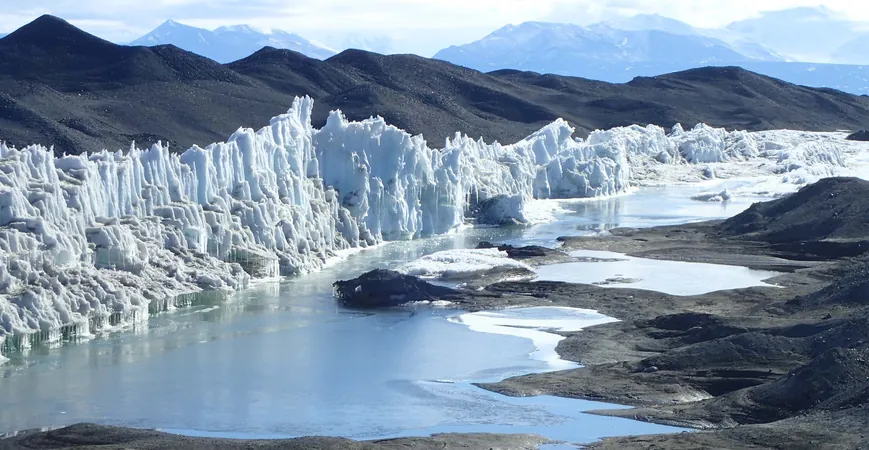
Unveiling Earth's Ancient Secrets: How Life Survived the Snowball Earth
2025-07-01
Author: Rajesh
A Glacial Enigma from Earth's Past
Hundreds of millions of years ago, our planet was trapped in an icy grip, an era aptly dubbed 'Snowball Earth.' During this critical period, temperatures fell dramatically, casting a chilling blanket over the majority of the globe, yet tiny cellular life managed to endure.
The Mystery of Meltwater Ponds
Recent research shed light on how ancient microorganisms navigated this frozen apocalypse. Scientists propose that these microscopic ancestors sought refuge in meltwater ponds that formed atop shallow ice sheets near the equator.
To investigate this theory, a team explored meltwater ponds on Antarctica's McMurdo Ice Shelf, believing the conditions mimic those that prevailed in equatorial regions during Snowball Earth.
Dr. Anne Jungblut, a microbial researcher from the Natural History Museum, highlighted the findings. "We discovered that these ponds are home to diverse communities of microorganisms," she stated.
A Window to Ancient Eukaryotic Life
Each pond tested revealed clear signs of eukaryotic life—complex organisms that are ancestors to the rich tapestry of life we recognize today. Fossil evidence confirms that eukaryotes thrived before and after the Snowball Earth event, suggesting that these meltwater havens played a pivotal role in their survival.
What Was Snowball Earth?
Snowball Earth refers to two glaciation events occurring between 635 and 720 million years ago during the Cryogenian Period, where global temperatures plummeted below -50°C. However, conditions near the equator remained variable, allowing pools of liquid water at temperatures close to 0°C.
These warmer ponds likely offered a sanctuary for complex life, fostering ecosystems that enabled survival amidst the harsh freeze.
The Microbial Mats: Nature's Ecosystems
In Antarctica’s meltwater ponds, microbial mats, formed by layers of bacteria and eukaryotes like amoeba and fungi, showcased thriving ecosystems. According to Dr. Jungblut, these mats function like forests, with cyanobacteria acting as trees that provide shelter and resources.
A Blueprint for Extraterrestrial Life
Studying microorganisms in extreme environments not only elucidates Earth’s early life but also illuminates the hunt for extraterrestrial life. The researchers detect life signs—known as biosignatures—by identifying molecules such as DNA and lipids.
One crucial molecule, sterols, found in all eukaryotic organisms, helped the team confirm the presence of complex life in these ponds.
By applying this method beyond Earth, scientists hope to uncover signs of life on icy celestial bodies, like Saturn’s moon Enceladus, which harbors liquid water beneath its surface.
The Quest Continues
As future missions aim to collect and analyze water samples from Enceladus’ geyser-like jets, understanding these biosignatures could greatly enhance our quest for life beyond our planet.
To dive deeper into the search for life on the icy moons of Jupiter and Saturn, visit our latest exhibition, 'Space: Could Life Exist Beyond Earth?' and explore the extraordinary possibilities that await.



 Brasil (PT)
Brasil (PT)
 Canada (EN)
Canada (EN)
 Chile (ES)
Chile (ES)
 Česko (CS)
Česko (CS)
 대한민국 (KO)
대한민국 (KO)
 España (ES)
España (ES)
 France (FR)
France (FR)
 Hong Kong (EN)
Hong Kong (EN)
 Italia (IT)
Italia (IT)
 日本 (JA)
日本 (JA)
 Magyarország (HU)
Magyarország (HU)
 Norge (NO)
Norge (NO)
 Polska (PL)
Polska (PL)
 Schweiz (DE)
Schweiz (DE)
 Singapore (EN)
Singapore (EN)
 Sverige (SV)
Sverige (SV)
 Suomi (FI)
Suomi (FI)
 Türkiye (TR)
Türkiye (TR)
 الإمارات العربية المتحدة (AR)
الإمارات العربية المتحدة (AR)